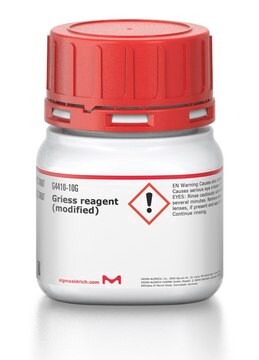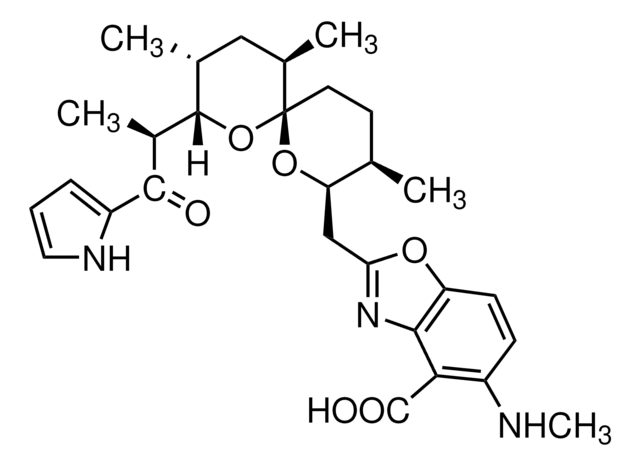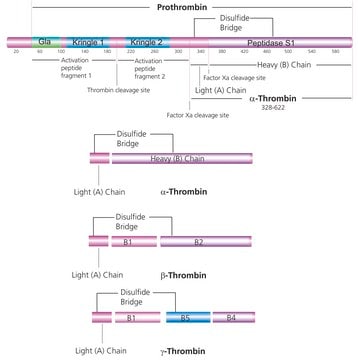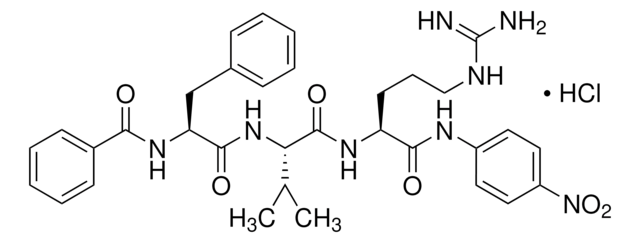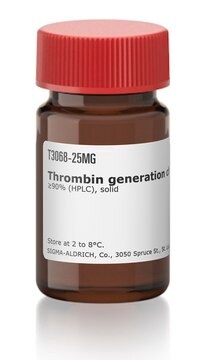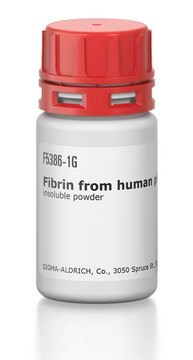Wszystkie zdjęcia(1)
Kluczowe dokumenty
H0393
Hirudin
recombinant, expressed in unspecified host, ≥7,000 ATU/mg protein, powder
Zaloguj sięWyświetlanie cen organizacyjnych i kontraktowych
About This Item
Polecane produkty
Nazwa produktu
Hirudin, recombinant, expressed in unspecified host, ≥7,000 ATU/mg protein (ATU = antithrombin units)
rekombinowane
expressed in unspecified host
Poziom jakości
Formularz
powder
aktywność właściwa
≥7,000 ATU/mg protein (ATU = antithrombin units)
masa cząsteczkowa
~7 kDa
rozpuszczalność
pyridine: soluble
water: soluble
Warunki transportu
dry ice
temp. przechowywania
−20°C
Szukasz podobnych produktów? Odwiedź Przewodnik dotyczący porównywania produktów
Zastosowanie
Antithrombotic efficacy by parenteral route is substantially prolonged by incorporation into cationic liposomes, which act as a sort of sustained-release device.
Właściwości fizyczne
The anticoagulant hirudin is a ~7 kDa acidic protein containing 65 amino acid residues. It occurs naturally in leeches (Hirudo medicinalis). It is the most potent natural inhibitor of both soluble and clot-bound thrombin. Hirudin binds thrombin with high affinity and covers more than 20% of the surface area of thrombin, occluding both the active site and exosite I (fibrinogen and PAR recognition site). This coverage blocks thrombus growth and platelet activation. Hirudin is not metabolized in the bloodstream of humans and is eliminated unchanged via kidney filtration. Native hirudin contains a sulfated tyrosyl residue (Tyr63), three disulfide bridges, and a high proportion of dicarboxylic acids. Hirudin is not glycosylated, and lacks tryptophan, arginine, and methionine residues. At least 20 isoforms have been identified and sequenced.
This recombinant hirudin product corresponds to the HV-1 variant sequence, with the exception that the Tyr63 residue is not sulfated.
Definicja jednostki
One antithrombin unit (ATU) will neutralize one NIH unit of thrombin at 37 °C, based on direct comparison to an NIH thrombin reference standard.
Rekonstytucja
Hirudin is soluble in water. The literature cites the use of "Dilution Fluid II" (35.7 mM acetic acid, 35.7 mM sodium diethyl barbiturate, 0.85% NaCl, 1% bovine serum albumin, and 0.5% PEG, pH 7.4) to dissolve hirudin (500 ATU/mL) and thrombin. Hirudin is reported to be soluble in pyridine, but practically insoluble in alcohol, ether, acetone, or benzene.
Komentarz do analizy
Protein determined by Lowry.
Ta strona może zawierać tekst przetłumaczony maszynowo.
Kod klasy składowania
11 - Combustible Solids
Klasa zagrożenia wodnego (WGK)
WGK 3
Temperatura zapłonu (°F)
Not applicable
Temperatura zapłonu (°C)
Not applicable
Środki ochrony indywidualnej
dust mask type N95 (US), Eyeshields, Gloves
Wybierz jedną z najnowszych wersji:
Masz już ten produkt?
Dokumenty związane z niedawno zakupionymi produktami zostały zamieszczone w Bibliotece dokumentów.
Klienci oglądali również te produkty
Hirudin as an inhibitor of thrombin.
Markwardt, F.
Methods in Enzymology, 19, 924-932 (1970)
[The reaction between hirudin and thrombin].
F MARKWARDT et al.
Hoppe-Seyler's Zeitschrift fur physiologische Chemie, 312(1-3), 85-98 (1958-01-01)
Hirudin and hirudin-based peptides.
S R Stone et al.
Methods in enzymology, 223, 312-336 (1993-01-01)
Serdar Duzgun et al.
Indian journal of plastic surgery : official publication of the Association of Plastic Surgeons of India, 47(1), 102-108 (2014-07-06)
The effect of recombinant hirudin, which is the most powerful antithrombotic agent, on flaps with venous insufficiency was investigated. Oedema and congestion are frequent on flaps, causing necrosis unpredictably. Venous insufficiency and thrombosis are experimentally and clinically more frequent than
R Bischoff et al.
Biochemistry, 32(2), 725-734 (1993-01-19)
Natural hirudin variant 2 with a lysine residue in position 47 (rHV2-Lys47) was produced in a genetically engineered strain of Saccharomyces cerevisiae as a secreted protein of 65 amino acids and purified to greater than 99% homogeneity. Only reversed-phase high-performance
Nasz zespół naukowców ma doświadczenie we wszystkich obszarach badań, w tym w naukach przyrodniczych, materiałoznawstwie, syntezie chemicznej, chromatografii, analityce i wielu innych dziedzinach.
Skontaktuj się z zespołem ds. pomocy technicznej
